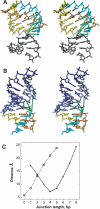Pseudoknot structures with conserved base triples in telomerase RNAs of ciliates
- PMID: 17827211
- PMCID: PMC2094054
- DOI: 10.1093/nar/gkm660
Pseudoknot structures with conserved base triples in telomerase RNAs of ciliates
Abstract
Telomerase maintains the integrity of telomeres, the ends of linear chromosomes, by adding G-rich repeats to their 3'-ends. Telomerase RNA is an integral component of telomerase. It contains a template for the synthesis of the telomeric repeats by the telomerase reverse transcriptase. Although telomerase RNAs of different organisms are very diverse in their sequences, a functional non-template element, a pseudoknot, was predicted in all of them. Pseudoknot elements in human and the budding yeast Kluyveromyces lactis telomerase RNAs contain unusual triple-helical segments with AUU base triples, which are critical for telomerase function. Such base triples in ciliates have not been previously reported. We analyzed the pseudoknot sequences in 28 ciliate species and classified them in six different groups based on the lengths of the stems and loops composing the pseudoknot. Using miniCarlo, a helical parameter-based modeling program, we calculated 3D models for a representative of each morphological group. In all cases, the predicted structure contains at least one AUU base triple in stem 2, except for that of Colpidium colpoda, which contains unconventional GCG and AUA triples. These results suggest that base triples in a pseudoknot element are a conserved feature of all telomerases.
Figures





Similar articles
-
A triple helix within a pseudoknot is a conserved and essential element of telomerase RNA.Mol Cell Biol. 2007 Mar;27(6):2130-43. doi: 10.1128/MCB.01826-06. Epub 2007 Jan 8. Mol Cell Biol. 2007. PMID: 17210648 Free PMC article.
-
Pyrimidine motif triple helix in the Kluyveromyces lactis telomerase RNA pseudoknot is essential for function in vivo.Proc Natl Acad Sci U S A. 2013 Jul 2;110(27):10970-5. doi: 10.1073/pnas.1309590110. Epub 2013 Jun 17. Proc Natl Acad Sci U S A. 2013. PMID: 23776224 Free PMC article.
-
Structure and folding of the Tetrahymena telomerase RNA pseudoknot.Nucleic Acids Res. 2017 Jan 9;45(1):482-495. doi: 10.1093/nar/gkw1153. Epub 2016 Nov 29. Nucleic Acids Res. 2017. PMID: 27899638 Free PMC article.
-
Structure and function of telomerase RNA.Curr Opin Struct Biol. 2006 Jun;16(3):307-18. doi: 10.1016/j.sbi.2006.05.005. Epub 2006 May 18. Curr Opin Struct Biol. 2006. PMID: 16713250 Review.
-
Telomerase is an unusual RNA-containing enzyme. A review.Biochemistry (Mosc). 1997 Nov;62(11):1206-15. Biochemistry (Mosc). 1997. PMID: 9467844 Review.
Cited by
-
The common ancestral core of vertebrate and fungal telomerase RNAs.Nucleic Acids Res. 2013 Jan 7;41(1):450-62. doi: 10.1093/nar/gks980. Epub 2012 Oct 23. Nucleic Acids Res. 2013. PMID: 23093598 Free PMC article.
-
An updated human snoRNAome.Nucleic Acids Res. 2016 Jun 20;44(11):5068-82. doi: 10.1093/nar/gkw386. Epub 2016 May 12. Nucleic Acids Res. 2016. PMID: 27174936 Free PMC article.
-
New models of Tetrahymena telomerase RNA from experimentally derived constraints and modeling.J Am Chem Soc. 2012 Dec 12;134(49):20070-80. doi: 10.1021/ja305636u. Epub 2012 Dec 3. J Am Chem Soc. 2012. PMID: 23163801 Free PMC article.
-
New Perspectives on DNA and RNA Triplexes As Effectors of Biological Activity.PLoS Genet. 2015 Dec 23;11(12):e1005696. doi: 10.1371/journal.pgen.1005696. eCollection 2015 Dec. PLoS Genet. 2015. PMID: 26700634 Free PMC article. Review.
-
Unraveling the structure and biological functions of RNA triple helices.Wiley Interdiscip Rev RNA. 2020 Nov;11(6):e1598. doi: 10.1002/wrna.1598. Epub 2020 May 22. Wiley Interdiscip Rev RNA. 2020. PMID: 32441456 Free PMC article. Review.
References
-
- Bertuch AA, Lundblad V. The maintenance and masking of chromosome termini. Curr. Opin. Cell Biol. 2006;18:247–253. - PubMed
-
- Autexier C, Lue NF. The structure and function of telomerase reverse transcriptase. Annu. Rev. Biochem. 2006;75:493–517. - PubMed
-
- Romero DP, Blackburn EH. A conserved secondary structure for telomerase RNA. Cell. 1991;67:343–353. - PubMed
-
- Lingner J, Hendrick LL, Cech TR. Telomerase RNAs of different ciliates have a common secondary structure and a permuted template. Genes Dev. 1994;8:1984–1998. - PubMed
-
- Chen JL, Blasco MA, Greider CW. Secondary structure of vertebrate telomerase RNA. Cell. 2000;100:503–514. - PubMed

